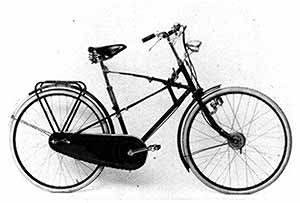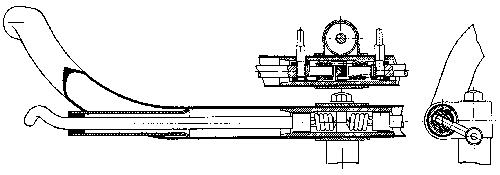1887: Foundation of the
"Simplex Automatic Machine Company" in Utrecht at the Stationdwarsstraat by the
Englishman Charles Bingham, one of the initiators and first president of the ANWB (Royal
Dutch Touring Club) in 1883.1890:
Simplex stops making small automats and starts producing Simplex-branded bicycles. The
company is now situated at the Leidscheweg.
1892: Simplex moves to a bigger
location at the Amsterdamschestraatweg. The staff increases from twelve to sixty workers.
1893: Piet Leeuwenberg from
Delft joins the management. In the same year, he is one of the initiators of the RAI
(Association of Dutch Bicycle Manufacturers). A few years later he will take over the
whole company. The Leeuwenbergs were on the Board until 1959.
1896: Simplex moves to the
Overtoom in Amsterdam. The company now employs 100 workers and soon produces about 5,000
units. Later Simplex produces not only bicycles but also motors, cars and
railway-vehicles. But bicycles remain the most important production section. Simplex is
now one of the biggest bicycle manufacturers of Holland and will keep this status for a
long time.
1899: The company is renamed
"NV Simplex Machine-, Rijwiel- en Automobielfabrieken" (Simplex Machine-,
Bicycle- and Carworks Inc.).
1908: The Simplex stretcher, a
tricycle for carrying patients, is the first type of carrier-bike not directly derived
from a common bicycle.
1909: Simplex develops the
Cycloïde-bearings (groove ball bearings for wheel-hubs and bracket with less friction),
which will be a feature of the more expensive models of Simplex for the next fiftyfive
years.
app. 1927: Simplex offers
bicycles with Simplex-made drum-brakes instead of the common rim-brakes. These drum-brakes
were used widely on Simplex bicycles until the late sixties.
1936: After some difficult years
the production facilities are being modernized to reach the capacity of 35,000 units per
year.
1939: Simplex introduces an
alloy cycle which weighs 12 1/4 kg.
1943 - end of 1945: The
production is greatly reduced because of the war.
1952: Simplex merges with
Locomotief. The new combination is quite successful. Around 1960 Simplex/Locomotief
produce some 55,000 bicycles per year, which is 10 % of the Dutch total production.

|
Simplex
"gliding bicycle"
|
1952/53: Simplex moves to a
bigger plant in the Pilotenstraat in Amsterdam with a capacity of 70,000 units. By 1954
the production facilities of Locomotief are completely transferred to the Pilotenstraat.
1955: The cumulated production
of Simplex bicycles reaches the numer of 1 milion.
1965: The sixties are a
difficult period for the bicycle industry in general. In 1965 the production of
Simplex/Locomotief is contracted out to Juncker in Apeldoorn. In Amsterdam only a sales
department remains.
1967: Simplex, Locomotief and
Juncker merge to form the Dutch Cycleworks Union (Verenigde Nederlandse Rijwielfabrieken -
VNR).
1968: The attempted rescue
through merging does not produce the desired result and Gazelle takes over VNR in 1968.
The Apeldoorn site is closed-down around 1971 and the three famous brands continue only as B-brands of
Gazelle.
2000: Gazelle sells the Simplex
brand to ZEG, a German bicycle retail purchase co-operation which is active in several
countries.
Simplex and Burgers were the biggest
Dutch cycleworks at the turn of the century. As early as 1891 an American customer ordered
100 bicycles from Simplex. Export destinations at that time were Denmark, France, Germany,
England, South Africa and South America. In the early years of the twentieth century
Simplex was a supplier of the Dutch army, together with Fongers and Burgers. Most of the
mounted parts were made by Simplex itself.

One of the special models of Simplex was the "gliding
bicycle", introduced in 1953. The seat of this model is fixed via a leaf spring, and
the forks are constructed with suspension as well. However, the gliding bicycle was no big
success and was only made a few years.

Another typical Simplex construction are handlebars with the
brake-rods mounted inside.

Simplex handlebars for
rod-brakes
It is difficult to estimate the bicycle
production of Simplex. There are still many old Simplex bikes from before the merger with
Locomotief, especially bicycles made between about 1949 and 1951, when they obviously sold
very well. Many of these are black, heavy ladies' roadsters with loop-frame, Simplex
drum-brakes and brake-rods.

The only known milestone is the celebration of the number of
1,000,000 sold Simplex bicycles in november 1955, almost two years after Gazelle
established the same production figure. Having started making bicycles very early, it is
very likely that in total numbers Simplex was the one but biggest Dutch bicycle
manufacturer at that moment.
|